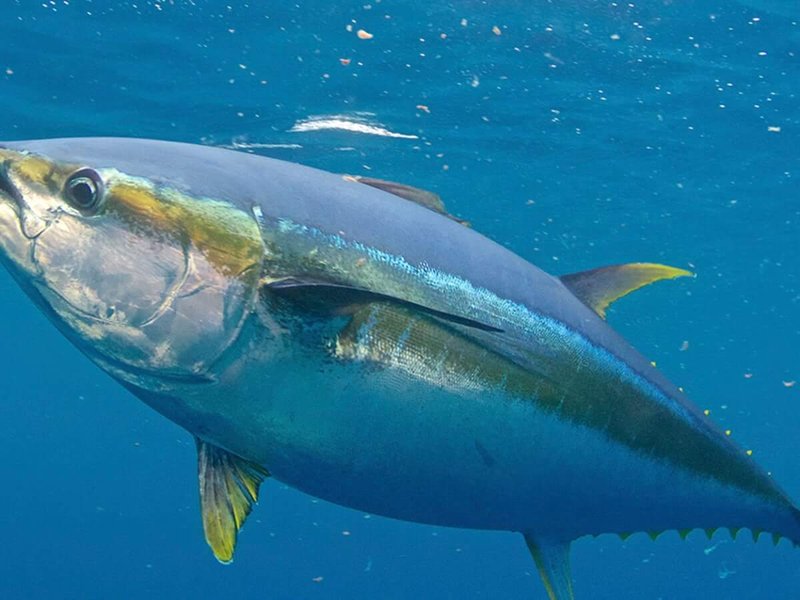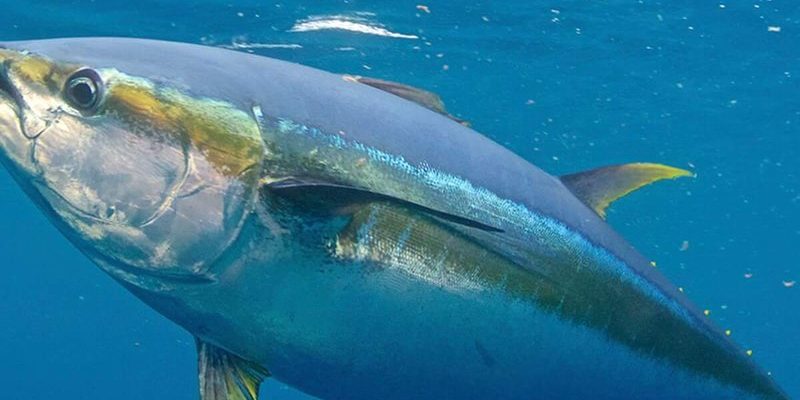
These sleek fish, known for their delicious taste and impressive size, have the ability to capture our attention not just as a meal but through their amazing capabilities. From their speed to their migratory habits, tuna are impressive athletes in the marine world. So grab a cup of coffee, and let’s dive into some truly fascinating facts about tuna!
1. Tuna Are Speed Demons
Tuna are known for their remarkable speed, which can reach up to 75 miles per hour. That’s like a car speeding down the highway! Their streamlined bodies are built for swift swimming, allowing them to chase down smaller fish like sardines and mackerel. Imagine a torpedo zipping through the water; that’s how a tuna moves.
You might be wondering why speed is so crucial for these fish. Well, it’s all about survival. When a tuna is moving quickly, it can evade predators like sharks, and it can also catch its prey more effectively. This makes tuna not just fast but incredibly skilled hunters in their underwater world.
2. They’re Masters of Migration
Tuna are also impressive migrators. Some species travel thousands of miles every year between feeding and spawning grounds. For instance, the Atlantic bluefin tuna journeys through the Atlantic Ocean, from the waters off New England to the warm seas around the Mediterranean.
Think of their migration like a yearly road trip. They follow specific routes, sometimes venturing into colder waters during certain seasons. Their ability to track temperature changes and water currents helps them find the best places to feed and reproduce. Diving a little deeper, you can see how these amazing fish connect various ocean habitats, playing a crucial role in marine ecosystems.
3. Tuna Can Regulate Their Body Temperature
Here’s the thing: most fish are cold-blooded, meaning their body temperature matches the water around them. But tuna are a bit special. They can actually regulate their body temperature, which is one of the reasons they can swim so fast.
This ability, known as regional endothermy, helps tuna maintain a warmer body temperature in cooler waters. Imagine a car engine that keeps running at top performance, regardless of the weather; that’s similar to how tuna operate. This adaptability allows them to hunt more effectively in varying ocean temperatures, giving them an edge over other fish.
4. They Have a Unique Heart Structure
Tuna have a unique heart structure that supports their high-speed lifestyle. Unlike many fish, their heart is a two-chambered design, which makes them more efficient swimmers. This heart structure allows them to pump oxygenated blood quickly, keeping their muscles fueled for all that speed.
If you think of a tuna’s heart as a racing engine, it’s designed for high performance. This unique adaptation not only supports their swift movements but also contributes to their impressive endurance during long migrations and hunts. It’s a classic example of nature’s engineering at work!
5. Different Species, Different Sizes
Tuna come in various species, each with unique traits and sizes. The bluefin tuna can weigh up to 1,500 pounds and grow over 10 feet long. On the other hand, you have the much smaller skipjack tuna, which weighs around 20 pounds and maxes out at about 3 feet.
This variety explains why tunas are such a diverse group. The size differences allow them to occupy different ecological niches. Bigger tunas often dominate as apex predators, while smaller species play different roles in the food web. When you think about it, it’s like having different types of cars—each designed for different needs and speeds.
6. Tuna’s Diet is Diverse
Tuna are carnivorous and have a varied diet that includes smaller fish, squid, and even crustaceans. Their eating habits can change based on their environment and the availability of prey. For example, when hunting in warm waters, they may target schools of sardines.
You might compare their hunting style to a buffet platter, where they sample whatever looks good. This dietary flexibility is key to their survival, ensuring they can thrive in various marine environments. Plus, it’s one reason why they are such significant players in ocean ecosystems.
7. Tuna Fishing is Both an Art and a Science
Fishing for tuna isn’t just about luck; it’s a blend of art and science. Fishermen use various techniques, from pole-and-line fishing to modern longlining, to catch these fish. There’s a lot of skill involved, and it often requires understanding tuna behavior and migration patterns.
Many anglers view it as a sport, where patience and knowledge come into play. There’s something special about battling a big tuna; it’s not just about the catch but also the experience. This blend of tradition and technique adds an extra layer of appreciation for these magnificent creatures.
8. Tuna Are Important in Ocean Ecosystems
Tuna play a crucial role in maintaining the balance of marine ecosystems. As top predators, they help control the populations of smaller fish, which in turn influences the health of marine habitats.
If you think about the ocean as a giant web, each species has a role to play. Tuna help keep that web intact by ensuring that no single species becomes too dominant. Their presence indicates a healthy ecosystem, making them vital to ocean health.
9. Overfishing is a Concern
Despite their strength and adaptability, tuna populations are facing pressures from overfishing. Many species, especially the bluefin tuna, are endangered due to high demand in markets, particularly for sushi and sashimi.
This is where sustainability comes into play. Responsible fishing practices and conservation efforts are essential to ensuring that future generations can enjoy these remarkable fish. It’s a reminder that we need to balance our appetites with the health of our oceans.
10. Tuna in Culture and Cuisine
Lastly, tuna are celebrated not just in ecosystems but also in culture and cuisine. From traditional sushi in Japan to Mediterranean dishes, tuna is a staple ingredient worldwide. The way people enjoy tuna varies greatly, showcasing its versatility in the kitchen and its cultural significance.
This cultural bond highlights the need for responsible consumption, as we can appreciate tuna not just for their taste but also for their ecological importance. Every bite should be savored, knowing the effort it takes to maintain healthy tuna populations.
In conclusion, tuna are more than just a delicious meal; they’re remarkable creatures that play essential roles in our oceans. Every fact about them—from their speed to their cultural significance—adds depth to our understanding of these fascinating fish. Protecting and preserving tuna populations is crucial, ensuring they continue to flourish in our oceans for generations to come. So next time you enjoy a tuna dish, remember the remarkable journey it took to get to your plate!

